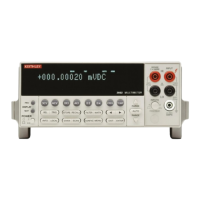Front Panel Operation
2-75
• Math performed on buffered readings (maximum and
minimum values, average, and standard deviation).
• Math performed on single readings as a part of a pass/
fail limits test.
• Math performed on scanned readings (ratio and delta).
The first category is configured from the CONFIGURE
MATH menu and is described in this paragraph. Math oper-
ations on buffered readings are available in multiple displays
of recalled data and are discussed in paragraph 2.8. Limit
tests are described in paragraph 2.12, under main menu op-
erations. Ratio and delta calculations on scanned channels
are available from the CONFIGURE SCAN menu, as dis-
cussed in paragraph 2.11.
Note that once enabled for a function, the polynomial and the
percentage calculations are in effect across function changes.
NOTE
The Model 2002 uses IEEE-754 floating
point format for math calculations.
2.10.1 Polynomial
This math operation allows you to mathematically manipu-
late normal display readings (X) according to the following
polynomial calculation:
Y = (a2)X
2
+ (a1)X + (a0)
where: X is the normal display reading
a2, a1 and a0 are user entered constants
Y is the displayed result
The value of the “a2”, “a1” and “a0” constants can be
changed through the CONFIGURE MATH menu (see para-
graph 2.10.4). The before and after calculation can be viewed
with one of the multiple displays, as described in paragraph
2.10.5. When necessary, the resulting Y value is displayed in
scientific notation.
The polynomial can be used in place of the more familiar
mX+b slope calculation. Simply let a2=0, a1=m and a0=b.
Over the bus, the mX+b calculation still exists and is coupled
to the polynomial calculation. Thus, changing a1 and/or a0
changes m and/or b respectively. See paragraph 3.11 for
details.
AVERAGING
Use this selection for a non-windowed averaging filter. A
message indicating the presently set number of reading con-
versions to average (the “stack” size) is displayed. If you
change the filter value, be sure to press ENTER.
Note that the number of reading conversions selected for the
averaging filter type is also coupled to that for the advanced
filter type.
ADVANCED
This selection is for an averaging filter with a noise window.
(It is not available with dB or dBm units, ratio or delta, tem-
perature or frequency.) A message indicating the presently
set number of reading conversions to average (the “stack”
size) is displayed.
You can retain the present filter value or you can key in an-
other value. In either case, press ENTER to display the max-
imum noise window.
The displayed level is the plus or minus percentage of range
window around the first reading conversion in the stack. Be
sure to press ENTER if you key in a different percentage.
Note that the number of reading conversions (filter value) se-
lected for the advanced filter is also coupled to that for the
averaging filter.
AVERAGING-MODE
This selection determines the mode of a digital filter for a
measurement function, either a moving or repeating average.
MOVING:
This item selects a moving filter, where a new
reading conversion is shifted into a stack as the oldest con-
version is shifted out (FIFO). When the stack is full, a simple
average is taken to yield a reading.
REPEAT:
This menu item selects a repeating filter, where an
average of a selected number of reading conversions is taken
for each reading.
2.10 Math
Model 2002 math operations are divided into four catego-
ries:
• Math performed on single readings (polynomial per-
cent, and percent deviation).

